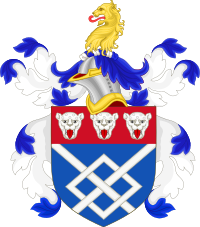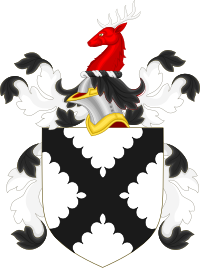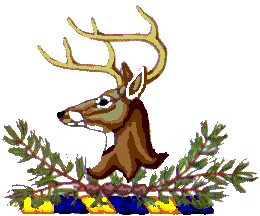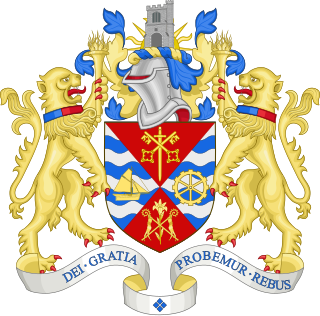Arms of vice presidents by century
18th century
| Arms | Name of vice president and blazon |
|---|---|
 | Arms of John Adams, 1st vice president, 1789–1797: Shield: Gules six crosses-crosslet fitchy Argent, on a chief Or three pellets, the center one charged with a fleur-de-lys and the other two with lions passant guardant Argent. Crest: A Lion passant holding in his dexter paw a cross-crosslet fitchy Argent. Motto:Libertatem amicitiam retinebis et fidem (Freedom, friendship and fidelity). [1] |
 | Arms of Thomas Jefferson, 2nd vice president, 1797–1801: Shield: Azure a fret and on a chief Gules three leopards' faces Argent Crest: A lion's head erased Or. Motto:Ab eo libertas a quo spiritus (The one who gives life gives liberty). [1] |
19th century
| Arms | Name of vice president and blazon |
|---|---|
| — | Aaron Burr, 3rd vice president, 1801–1805: No arms known |
 | Arms of George Clinton, 4th vice president, 1805–1812: Shield: Argent, six cross crosslets fitchy Sable on a chief Azure two mullets Or pierced Gules Crest: Out of a ducal coronet Gules a plume of five ostrich feathers Argent banded by a ribbon Azure Motto:Cara patria, carior libertas (Dear fatherland, dearer freedom) |
| — | Elbridge Gerry, 5th vice president, 1813–1814: No arms known |
 | Arms of Daniel D. Tompkins, 6th vice president, 1817–1825: Shield: Azure, on a chevron between three cock-pheasants close Or three cross-crosslets Sable Crest: A unicorn's head, erased, per fess, Argent and Or, armed and maned, counterchanged, gorged with a chaplet of laurel, Vert. |
 | Arms of John C. Calhoun, 7th vice president, 1825–1832: Shield: Argent, a saltire engrailed Sable Crest: A hart's head couped Gules attired Argent Supporters: Two ratch-hounds Argent, collared Sable Motto:Si je puis (If I may) |
 | Arms of Martin van Buren, 8th vice president, 1833–1837: Shield: Per pale, Or a greyhound rampant contourny Gules, and Gules two bars embattled-counterembattled Or Crest: A greyhound rampant between the wings of a vol Gules and Or. [2] |
| — | Richard Mentor Johnson, 9th vice president, 1837–1841: No arms known |
| — | John Tyler, 10th vice president, 1841: No arms known |
| — | George M. Dallas, 11th vice president, 1845–1849: No arms known |
| — | Millard Fillmore, 12th vice president, 1849–1850: No arms known |
| — | William R. King, 13th vice president, 1853: No arms known |
| — | John C. Breckinridge, 14th vice president, 1857–1861: No arms known |
| — | Hannibal Hamlin, 15th vice president, 1861–1865: No arms known |
| — | Andrew Johnson, 16th vice president, 1865: No arms known |
| — | Schuyler Colfax, 17th vice president, 1869–1873: No arms known |
| — | Henry Wilson, 18th vice president, 1873–1875: No arms known |
| — | William A. Wheeler, 19th vice president, 1877–1881: No arms known |
 | Arms of Chester A. Arthur, 20th vice president, 1881: Shield: Gules a chevron Argent between three rests (clarions) Or. Crest: A falcon rising proper belled and jessed Or. Motto:Impelle obstantia (Thrust aside obstacles). [3] |
| — | Thomas A. Hendricks, 21st vice president, 1885: No arms known |
| — | Levi P. Morton, 22nd vice president, 1889–1893: No arms known |
| — | Adlai Stevenson I, 23rd vice president, 1893–1897 No arms known |
| — | Garret Hobart, 24th vice president, 1897–1899: No arms known |
20th century
| Arms | Name of vice president and blazon |
|---|---|
 | Arms of Theodore Roosevelt, 25th vice president, 1901: Shield: Argent upon a grassy mound a rose bush proper bearing three roses Gules barbed and seeded proper Crest: From a wreath Argent and Gules three ostrich plumes each per pale Gules and Argent Motto:Qui plantavit curabit (He who planted will preserve). [4] |
| — | Charles W. Fairbanks, 26th vice president, 1905–1909: No known arms |
 | Arms of James S. Sherman, 27th vice president, 1909–1912: Shield: Or, a Lion rampant Sable between three oak leaves Vert Crest: A sea lion, sejant Sable charged on the shoulder with three bezants, two and one |
| — | Thomas R. Marshall, 28th vice president, 1913–1921: No arms known |
 | Arms of Calvin Coolidge, 29th vice president, 1921–1923: Attributed by Henry Bond, no evidence Calvin Coolidge ever bore these arms. [5] Shield: Vert a griffin segreant Or. Crest: A demi-griffin segreant Or. Motto:Virtute et fide (By valor and faith) |
| — | Charles G. Dawes, 30th vice president, 1925–1929: No arms known |
| — | Charles Curtis, 31st vice president, 1929–1933: No arms known |
| — | John Nance Garner, 32nd vice president, 1933–1941: No arms known |
| — | Henry A. Wallace, 33rd vice president, 1941–1945: No arms known |
| — | Harry S. Truman, 34th vice president, 1945: No arms known |
| — | Alben W. Barkley, 35th vice president, 1949–1953 No arms known |
| — | Arms of Richard Nixon, 36th vice president, 1953–1961: No known arms |
 | Arms of Lyndon Johnson, 37th vice president, 1961–1963: Shield: Azure on a saltire Gules fimbriated Argent between four eagles displayed a mullet Or. Crest: On a wreath of the colors an armed hand Argent supporting an eagle rising Or. Motto:Nobilitatis virtus non stemma character (Virtue, not lineage, is the mark of nobility) |
| — | Hubert Humphrey, 38th vice president, 1965–1969: No arms known |
 | Arms of Spiro Agnew, 39th vice president, 1969–1973: Shield: Azure, on a cross between four horses' heads couped Argent, a cross botonny Gules Crest: A hand couped proper holding a sceptre of office Supporters: Dexter a Greek statesman and sinister a Greek warrior both proper. Motto: Do all good |
| — | Gerald Ford, 40th vice president, 1973–1974: No arms known |
| — | Nelson Rockefeller, 41st vice president, 1974–1977: No arms known |
| — | Walter Mondale, 42nd vice president, 1977–1981: No arms known |
| — | George H. W. Bush, 43rd vice president, 1981–1989: No arms known |
| — | Dan Quayle, 44th vice president, 1989–1993: No arms known |
| — | Al Gore, 45th vice president, 1993–2001: No arms known |
21st century
| Arms | Name of vice president and blazon |
|---|---|
| — | Dick Cheney, 46th vice president, 2001–2009: No arms known |
| — | Joe Biden, 47th vice president, 2009–2017: No arms known |
| — | Mike Pence, 48th vice president, 2017–2021: No arms known |
| — | Kamala Harris, 49th vice president, 2021–present: No arms known |














